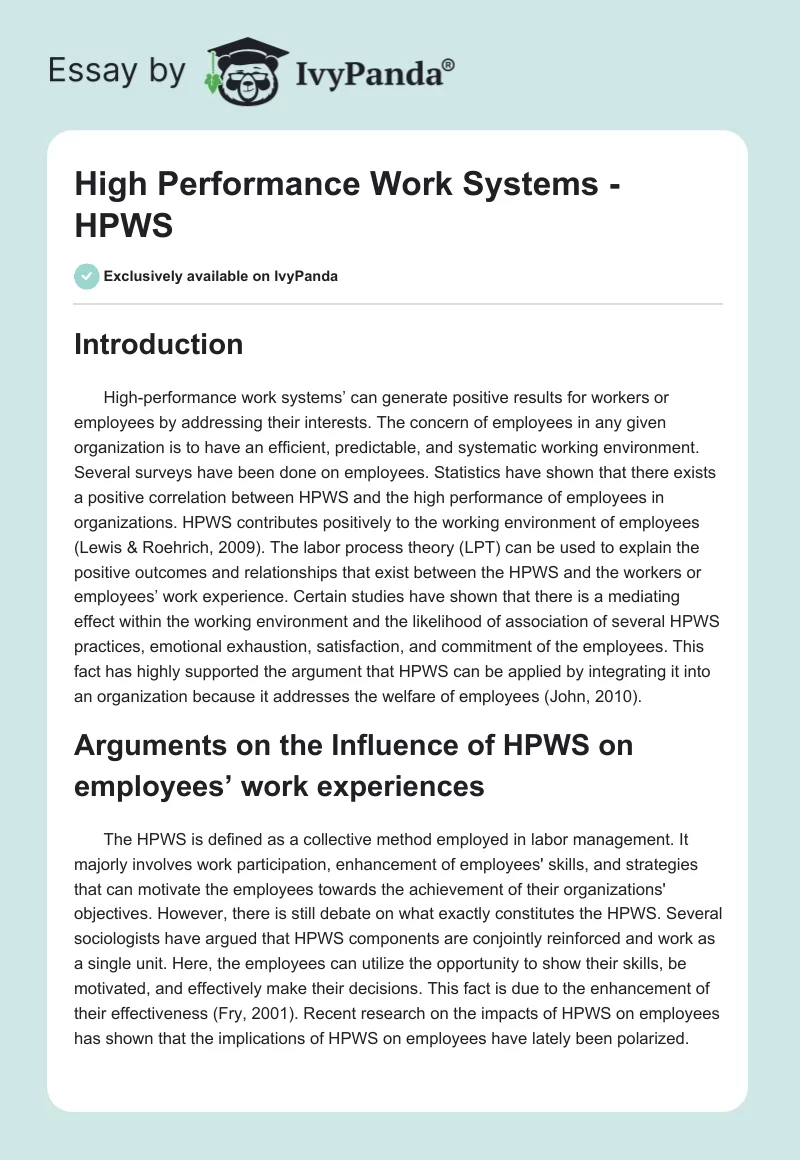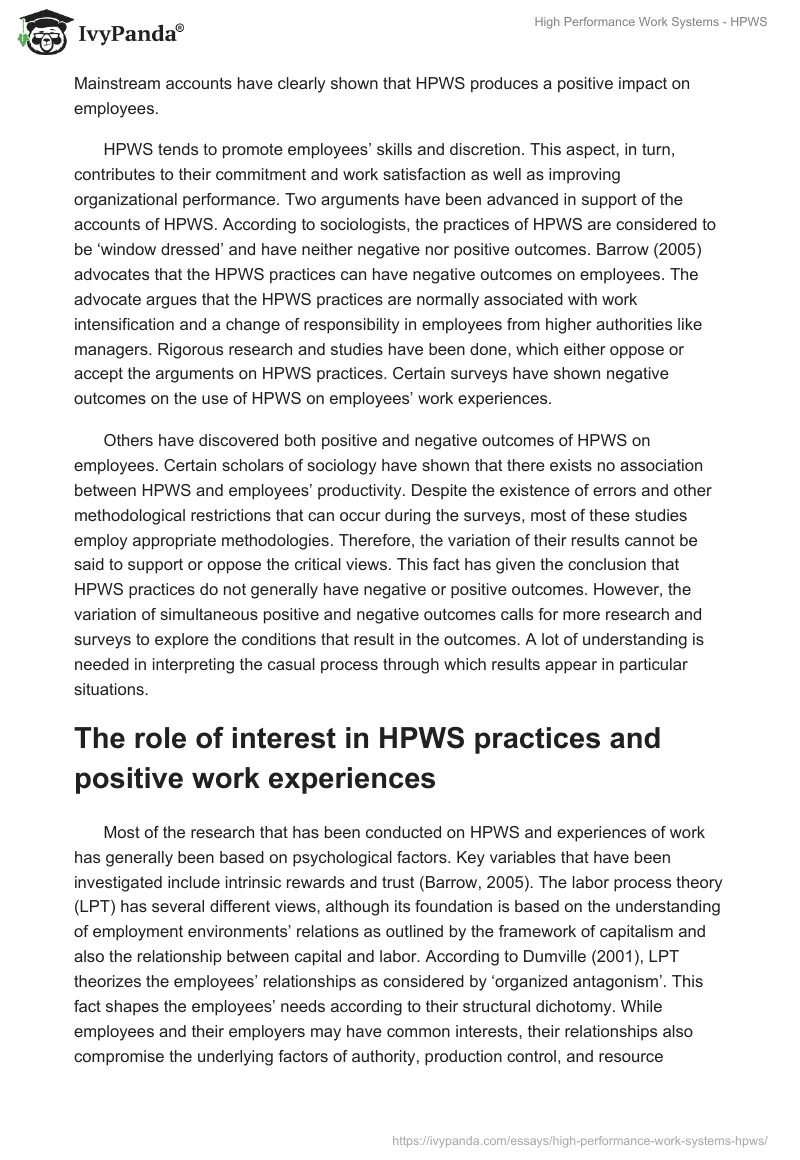Introduction
High-performance work systems’ can generate positive results for workers or employees by addressing their interests. The concern of employees in any given organization is to have an efficient, predictable, and systematic working environment. Several surveys have been done on employees. Statistics have shown that there exists a positive correlation between HPWS and the high performance of employees in organizations. HPWS contributes positively to the working environment of employees (Lewis & Roehrich, 2009).
The labor process theory (LPT) can be used to explain the positive outcomes and relationships that exist between the HPWS and the workers or employees’ work experience. Certain studies have shown that there is a mediating effect within the working environment and the likelihood of association of several HPWS practices, emotional exhaustion, satisfaction, and commitment of the employees. This fact has highly supported the argument that HPWS can be applied by integrating it into an organization because it addresses the welfare of employees (John, 2010).
Arguments on the Influence of HPWS on Employees’ Work Experiences
The HPWS is defined as a collective method employed in labor management. It majorly involves work participation, enhancement of employees’ skills, and strategies that can motivate the employees towards the achievement of their organizations’ objectives. However, there is still debate on what exactly constitutes the HPWS.
Several sociologists have argued that HPWS components are conjointly reinforced and work as a single unit. Here, the employees can utilize the opportunity to show their skills, be motivated, and effectively make their decisions. This fact is due to the enhancement of their effectiveness (Fry, 2001). Recent research on the impacts of HPWS on employees has shown that the implications of HPWS on employees have lately been polarized. Mainstream accounts have clearly shown that HPWS produces a positive impact on employees.
HPWS tends to promote employees’ skills and discretion. This aspect, in turn, contributes to their commitment and work satisfaction as well as improving organizational performance. Two arguments have been advanced in support of the accounts of HPWS. According to sociologists, the practices of HPWS are considered to be ‘window dressed’ and have neither negative nor positive outcomes.
Barrow (2005) advocates that the HPWS practices can have negative outcomes on employees. The advocate argues that the HPWS practices are normally associated with work intensification and a change of responsibility in employees from higher authorities like managers. Rigorous research and studies have been done, which either oppose or accept the arguments on HPWS practices. Certain surveys have shown negative outcomes on the use of HPWS on employees’ work experiences.
Others have discovered both positive and negative outcomes of HPWS on employees. Certain scholars of sociology have shown that there exists no association between HPWS and employees’ productivity. Despite the existence of errors and other methodological restrictions that can occur during the surveys, most of these studies employ appropriate methodologies. Therefore, the variation of their results cannot be said to support or oppose the critical views. This fact has given the conclusion that HPWS practices do not generally have negative or positive outcomes. However, the variation of simultaneous positive and negative outcomes calls for more research and surveys to explore the conditions that result in the outcomes. A lot of understanding is needed in interpreting the casual process through which results appear in particular situations.
The Role of Interest in HPWS Practices and Positive Work Experiences
Most of the research that has been conducted on HPWS and experiences of work has generally been based on psychological factors. Key variables that have been investigated include intrinsic rewards and trust (Barrow, 2005). The labor process theory (LPT) has several different views, although its foundation is based on the understanding of employment environments’ relations as outlined by the framework of capitalism and also the relationship between capital and labor.
According to Dumville (2001), LPT theorizes the employees’ relationships as considered by ‘organized antagonism’. This fact shapes the employees’ needs according to their structural dichotomy. While employees and their employers may have common interests, their relationships also compromise the underlying factors of authority, production control, and resource distribution. Therefore, interests are fundamental to LPT’s explanations of relations within the working environments. Interest-based theories have been criticized because of their assumption that management interest and labor are predetermined.
This fact makes it difficult to explain the variation of compromise and conflicts that may occur in particular situations. According to Aaker and McLoughlin (2010), new management strategies may, to a certain degree, meet the employees’ and management needs. This fact suggests that HPWS practices can address both the needs of the employees and management. This aspect gives a lot of understanding of the mutual benefits that are as a result of HPWS and also simultaneously observing the fact that the manager-employee conflict is always in existence.
Aaker and McLoughlin (2010), continue to argue that capital interests mainly involve operational performances, competition, and employee management so that they can be efficient and effective in achieving organizational goals. Several surveys have concluded that HPWS practices have outcomes that are related to management needs. Aaker and McLoughlin (2010) described the employees’ needs as payment, better employment environment, and participation in decision making. However, it still remains unclear whether HPWS reflects on the workers’ needs.
Why Order and Predictability are Expected in Employees’ Interests
According to Brown (2001), the ‘disciplined worker thesis’ can be used as a basis for the explanation of the employees’ predictability and order. The author describes that employees need an orderly and well-disciplined employment environment. Evidence from Saylor (2012) has shown that routines are advantageous to employees because they structure and organize their workday. This fact provides a form of coherence, thus making the employees work enjoyable and interesting. Predictable and well-ordered employment environments have a high possibility of offering the workers a chance to control their work. This fact is because the employees know what to anticipate and expect in terms of what is expected of them and other employees and also the managerial expectations (Dumville, 2001).
The experience of the employees’ work can also be viewed on the basis of the degree of certainty of the employment and also the manner in which it may bring about employee control. The ability of an employee to have the best performance is dependent on the ‘dignity’ of the workplace. Work that is done in an orderly and predictable manner makes tasks easier and more effective. A lot of evidence has been used to show the lack of control of work by the employees and the disorderliness and that the unpredictability of the working environment usually causes the workers to suffer from negative work orientations, stress, negligence, and also physical ailments. This fact, therefore, shows that a predictable and orderly employment environment will have a positive outcome on the interests of the employees.
How High-Performance Work Practices Increase Order and Predictability
The foundation of HPWS is based on work organization. This fact tends to give the workers a better sense of pleasure and flexibility in terms of how they perform their duties at work. Other features of work organization include multi-tasking, semi-autonomous and autonomous teamwork, the use of different skills, completion of tasks, and constant feedback. Individual jobs that mainly represent non-tailored perspectives also provide a form of discretion towards the work that the employee is doing. These work features work well when used hand in hand with information sensitization and sharing and also consultations, which can ensure that the workers have enough information about their workplace, decisions, and their expected outcomes.
All these components that contribute to work organization have shown to increase the degree at which workers perform best and also enjoy their work. These features also are likely to increase the employees’ control over their work, detailed information on effective production, and also a comprehensive account of the expected high performance. Semi-autonomous and autonomous teamwork also tends to have a certain influence over productivity and also provides awareness about all the processes within the employment environment (Jeong, & Nor, 2007).
HPSW also contains a wide spectrum of inducements and other strategies whose core function is to offer motivation to the employees. The practices may include performance pay systems, profit, and gain sharing, and also employee ownership platforms. The most important feature in HPWS is the utilization of performance management approaches to create a payment platform based on the employees’ performance and also appraisal systems that are performance-based.
These performance rewards and payoffs are meant to motivate the employees to reach and attain certain expected targets and also enhance their performance feedbacks hence increasing the degree of order and predictability in their working environments. For an effective and efficient HPWS, the employees’ skills are required. Effective and efficient work organizations, together with good performance management platforms, display high performance when combined with the requisite skills of the employees.
A sophisticated employment system that involves specific selection and a lot of training can provide the employees with the required skills. Training of the employees can lead to a predictable and orderly work environment because the employees are fully aware of their duties and their expected expectations. However, the effect of training on predictability is highly dependent on its contents. For instance, the training that is aimed at developing production progressions and operations to an employee is likely to have a stronger effect than training that involves a narrow range of technical skills.
Conclusion
Many of the research and surveys conclude that HPWS practices are associated with positive outcomes within the employees’ working environments. HPWS practices have also been associated with predictable and orderly workplaces, which in turn bring about the positive experiences of work (Plunkett, 2008). Surveys have also shown that sociologically based analyses that expose the employees’ interests provide a vital contribution to the conventional psychological based postulations of HPWS. This fact, therefore, provides a foundation for the development of the labor process theory.
References
Aaker, D & McLoughlin, D 2010,Strategic Market Management – Global Perspectives, John Wiley & Sons Ltd,West Sussex.
Barrow, W 2005, Robert Bruce & the Community of the Realm of Scotland (4th ed.), Edinburgh University Press, Edinburgh.
Brown, D 2001 “Kenneth mac Alpin”. In M. Lynch. The Oxford Companion to Scottish History, Oxford University Press, Oxford.
Dumville, D 2001, “St Cathróe of Metz and the Hagiography of Exoticism”.Irish Hagiography: Saints and Scholars, Four Courts Press, Dublin.
Fry, B 2001, Mastering Public Administration; from Max Weber to Dwight Waldo, Chatham, Chatham House Publishers, Inc., New Jersey.
Jeong, C & Nor, F 2007, Principles of Public Administration: An Introduction, Karisma Publications, Kuala Lumpur.
John, R 2010, Network Nation: Inventing American Telecommunications 520 pages; traces the evolution of the country’s telegraph and telephone networks, Harvard University Press, Harvard.
Lewis, M & Roehrich, J 2009, Contracts, Relationships and Integration: Scheduling, and Controlling, John Wiley &Sons, New York City.
Plunkett, J W 2008, Plunkett’s Telecommunications Industry Almanac Etisalat Financials, Choice Magazine, Houston.
Saylor, M 2012,The Mobile Wave: How Mobile Intelligence Will Change Everything, Perseus Books/Vanguard Press, New York.


